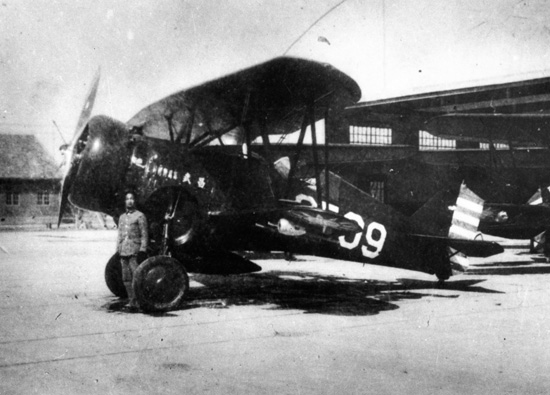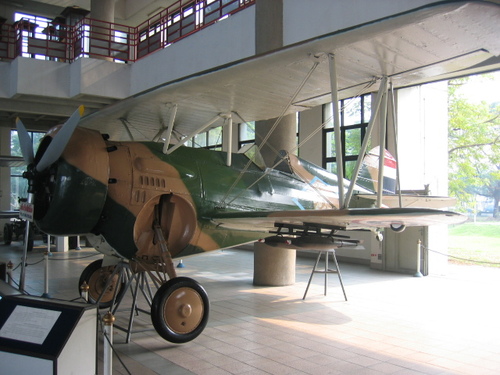Curtiss BF2C on:
[Wikipedia]
[Google]
[Amazon]
The Curtiss BF2C Goshawk (Model 67) was a United States 1930s naval biplane aircraft that saw limited success and was part of a long line of Hawk Series

 Twenty-seven BF2C-1 were ordered by the U.S. Navy, with a raised rear turtledeck, a semi-enclosed cockpit, and a metal-framed lower wing. It was armed with two .30 calibre Browning
Twenty-seven BF2C-1 were ordered by the U.S. Navy, with a raised rear turtledeck, a semi-enclosed cockpit, and a metal-framed lower wing. It was armed with two .30 calibre Browning
 ;
* Army Aviation Service operated ten Model 68A ''Hawk III'' and 1 Model 79 ''Hawk IV''.
;
*
;
* Army Aviation Service operated ten Model 68A ''Hawk III'' and 1 Model 79 ''Hawk IV''.
;
*
Images
"Fast Navy Plane Has Retractable Wheels"
''Popular Science'', July 1934 {{Thai fighter designations BF02C 1930s United States fighter aircraft 1930s United States bomber aircraft Single-engined tractor aircraft Biplanes Carrier-based aircraft Aircraft first flown in 1933 World War II Chinese fighter aircraft
airplane
An airplane or aeroplane (informally plane) is a fixed-wing aircraft that is propelled forward by thrust from a jet engine, Propeller (aircraft), propeller, or rocket engine. Airplanes come in a variety of sizes, shapes, and wing configurat ...
s made by the Curtiss Aeroplane and Motor Company for the American military, and for export as the Model 68 Hawk III.
Design and development
TheUnited States Navy
The United States Navy (USN) is the maritime service branch of the United States Armed Forces and one of the eight uniformed services of the United States. It is the largest and most powerful navy in the world, with the estimated tonnage ...
and Curtiss felt that the F11C-2 possessed development potential, and the Navy decided to procure a variant with retractable landing gear. This variant, which still had the F11C-2's classic "Hawk" wood wing with its flat-bottomed Clark Y airfoil, was designated XF11C-3 by the Navy and Model 67 by Curtiss. The main gear retraction system was inspired by the Grover Loening
Grover Cleveland Loening (September 12, 1888 – February 29, 1976) was an American aircraft manufacturer.
Biography
Loening was born in Bremen, in what was then Imperial Germany, on September 12, 1888, while his American-born father was statione ...
-designed system on the Grumman XFF-1 prototype, and was manually operated.
The XF11C-3 was first delivered to the USN in May 1933, with a Wright R-1820-80 radial engine
The radial engine is a reciprocating type internal combustion engine configuration in which the cylinders "radiate" outward from a central crankcase like the spokes of a wheel. It resembles a stylized star when viewed from the front, and is ...
rated at . Trials revealed a increase in speed over the F11C-2, but the extra weight caused a decrease in maneuverability. The Navy felt the handling degradation was more than offset by the increase in speed, however. During testing the XF11C-3 had its wood-framed wing replaced by the metal-structured, biconvex, NACA 2212 airfoil wing, and soon after was redesignated XBF2C-1 (Model 67A) in keeping with the new Bomber-Fighter category.
Operational history

 Twenty-seven BF2C-1 were ordered by the U.S. Navy, with a raised rear turtledeck, a semi-enclosed cockpit, and a metal-framed lower wing. It was armed with two .30 calibre Browning
Twenty-seven BF2C-1 were ordered by the U.S. Navy, with a raised rear turtledeck, a semi-enclosed cockpit, and a metal-framed lower wing. It was armed with two .30 calibre Browning machine gun
A machine gun is a fully automatic, rifled autoloading firearm designed for sustained direct fire with rifle cartridges. Other automatic firearms such as automatic shotguns and automatic rifles (including assault rifles and battle rifles) ar ...
s and three hardpoints for of external stores. Delivered in October 1934, they were assigned to VB-5B on the aircraft carrier , but served only a few months before difficulties with the landing gear led to their withdrawal. In spite of its short service run, many of the innovations developed for the Goshawk line found wide use in Navy aircraft in the years that followed. They were the last Curtiss fighter accepted for service with the U.S. Navy.
The export version Model 68 Hawk III reverted to the classic wood/Clark Y
Clark Y is the name of a particular airfoil profile, widely used in general purpose aircraft designs, and much studied in aerodynamics over the years. The profile was designed in 1922 by Virginius E. Clark using thickness distribution of the Germ ...
wings and was powered by a R-1820-F53. Chinese Hawk IIIs served as multi-purpose aircraft when combat operations against the Imperial Japanese Army
An army (from Old French ''armee'', itself derived from the Latin verb ''armāre'', meaning "to arm", and related to the Latin noun ''arma'', meaning "arms" or "weapons"), ground force or land force is a fighting force that fights primarily on ...
and Navy
A navy, naval force, or maritime force is the branch of a nation's armed forces principally designated for naval and amphibious warfare; namely, lake-borne, riverine, littoral, or ocean-borne combat operations and related functions. It in ...
Air Forces began in earnest in August 1937, particularly with the Battle of Shanghai
The Battle of Shanghai () was the first of the twenty-two major engagements fought between the National Revolutionary Army (NRA) of the Republic of China (ROC) and the Imperial Japanese Army (IJA) of the Empire of Japan
The also ...
and Nanjing
Nanjing (; , Mandarin pronunciation: ), alternately romanized as Nanking, is the capital of Jiangsu province of the People's Republic of China. It is a sub-provincial city, a megacity, and the second largest city in the East China region. T ...
, and were considered the Nationalist Chinese Air Force's frontline fighter-pursuit aircraft along with their inventory of Hawk IIs, Boeing Model 281 "Peashooters" and Fiat CR.32s. Col. Gao Zhihang
Gao Zhihang (; 14 May 1907 – 21 November 1937) was a flying ace of the Republic of China in the Second Sino-Japanese War. On August 14, 1937, the 4th Air Force Group commanded by Gao shot down six Japanese planes over Jianqiao, while sufferi ...
scored a double-kill against the superior Mitsubishi A5M "Claude" (predecessor of the A6M "Zero") over Nanjing
Nanjing (; , Mandarin pronunciation: ), alternately romanized as Nanking, is the capital of Jiangsu province of the People's Republic of China. It is a sub-provincial city, a megacity, and the second largest city in the East China region. T ...
on 12 October, 1937 while at the controls of his Hawk III numbered "IV-I" (4th Pursuit Group, Commander).
As the air-interdiction and close-air support for the National Revolutionary Army of China continued at the Battle of Shanghai on 14 October, 1937, the Chinese Air Force launched a major strike against Japanese positions in Shanghai at 16:00 hours with a uniquely mixed force of three Curtiss Hawk IIIs escorting three B-10s, two He-111As, five O-2MCs and five Gammas from Nanjing in the late-afternoon, and then one strike launched every hour from Nanking to Shanghai in the evening until 03:00 hours on 15 October. These combination of attacks with the Hawk IIIs were used against both the Imperial Japanese Army and Navy Air Forces, and against both ground and naval targets with considerable success through the end of 1937, before being superseded by the better-armed and faster Polikarpov I-15
The Polikarpov I-15 (russian: И-15) was a Soviet biplane fighter aircraft of the 1930s. Nicknamed ''Chaika'' (''russian: Чайка'', "Seagull") because of its gulled upper wings,Gunston 1995, p. 299.Green and Swanborough 1979, p. 10. it was ...
and I-16 fighters that were supplied to the Chinese Air Force through the Sino-Soviet Treaty of 1937.
In early 1935, Thailand placed an order for 24 Curtiss Hawk IIIs at a cost of 63,900 Baht each, and a manufacturing license was also bought. The first 12 Hawk IIIs were shipped to Thailand in August and the remaining 12 arrived in late 1935, which were named Fighter Type 10. A total of 50 Hawk IIIs were locally built during 1937 and 1939. The type was used against the French in the Franco-Thai War
The Franco-Thai War (October 1940 – January 28, 1941, th, กรณีพิพาทอินโดจีน, Krṇī phiphāth xindocīn; french: Guerre franco-thaïlandaise) was fought between History of Thailand (1932–1973), Thailand an ...
and the Japanese invaders in December 1941, then relegated for use as trainers. Some of these aircraft were still active in 1949 and one airframe (KH-10) survives in the Royal Thai Air Force Museum
The Royal Thai Air Force Museum is located in Don Mueang District, Bangkok, Thailand. It is located on the Phahonyothin Road just to the south of Wing 6 of the domestic terminal of the Don Mueang Airport. It was served by the Royal Thai Air Force ...
.. Unofficial site that has a better photo and a bit more history.
The Model 79 Hawk IV demonstrator had a fully enclosed cockpit and a R-1820-F56.
Variants
;XBF2C-1 Hawk :The XF11C-3 prototype redesignated as a fighter-bomber. ;BF2C-1 Goshawk (Model 67A) :Production version of the XF11C-3; 27 built. ;Hawk III (Model 68) :Export version of BF2C-1 with an R-1820-F53 for Argentina, China, Thailand and Turkey; 137 built. ;Hawk IV (Model 79) :Export version with an R-1820-F56 engine; one demonstrator built.Operators
 ;
* Army Aviation Service operated ten Model 68A ''Hawk III'' and 1 Model 79 ''Hawk IV''.
;
*
;
* Army Aviation Service operated ten Model 68A ''Hawk III'' and 1 Model 79 ''Hawk IV''.
;
*Republic of China Air Force
The Republic of China Air Force, retroactively known by its historical name the Chinese Air Force and unofficially referred to as the Taiwanese Air Force, is the military aviation branch of the Republic of China Armed Forces, currently based ...
operated 102 Model 68C ''Hawk III''
;
*Royal Thai Air Force
"Royal Thai Air Force March"
, mascot =
, anniversaries = 9 April 1937 (Royal Thai Air Force Day)
, equipment =
, equipment_label =
, battles ...
operated 24 Model 68B ''Hawk III''
;
*Turkish Air Force
The Turkish Air Force ( tr, ) is the aerial warfare service branch of the Turkish Armed Forces. The Turkish Air Force can trace its origins back to June 1911 when it was founded by the Ottoman Empire, however, the air force as it is known to ...
operated one Model 68B ''Hawk III''
;
*United States Navy
The United States Navy (USN) is the maritime service branch of the United States Armed Forces and one of the eight uniformed services of the United States. It is the largest and most powerful navy in the world, with the estimated tonnage ...
operated 27 BF2C-1s
Specifications (Hawk III)
References
Further reading
* * *External links
Images
"Fast Navy Plane Has Retractable Wheels"
''Popular Science'', July 1934 {{Thai fighter designations BF02C 1930s United States fighter aircraft 1930s United States bomber aircraft Single-engined tractor aircraft Biplanes Carrier-based aircraft Aircraft first flown in 1933 World War II Chinese fighter aircraft